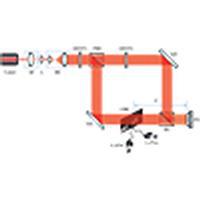Our official English website, www.x-mol.net, welcomes your
feedback! (Note: you will need to create a separate account there.)
Learning-based nonparametric autofocusing for digital holography
Optica ( IF 8.4 ) Pub Date : 2018-03-22 , DOI: 10.1364/optica.5.000337 Zhenbo Ren , Zhimin Xu , Edmund Y. Lam
Optica ( IF 8.4 ) Pub Date : 2018-03-22 , DOI: 10.1364/optica.5.000337 Zhenbo Ren , Zhimin Xu , Edmund Y. Lam

|
In digital holography, it is crucial to extract the object distance from a hologram in order to reconstruct its amplitude and phase. This is known as autofocusing, which is conventionally solved by first reconstructing a stack of images, and then the sharpness of each reconstructed image is computed using a focus metric such as entropy or variance. The distance corresponding to the sharpest image is considered the focal position. This approach, while effective, is computationally demanding and time-consuming. To cope with this problem, we turn to machine learning, where we cast the autofocusing as a regression problem, with the focal distance being a continuous response corresponding to each hologram. Therefore, distance estimation is converted to hologram prediction, which we solve by designing a powerful convolutional neural network trained by a set of holograms acquired a priori. Experimental results show that this allows fast autofocusing without reconstructing an image stack, even when the physical parameters of the optical setup are unknown.
中文翻译:

基于学习的数字全息非参数自动对焦
在数字全息术中,至关重要的是从全息图中提取物距,以重建其振幅和相位。这被称为自动聚焦,通常通过首先重建一堆图像来解决,然后使用诸如熵或方差之类的聚焦度量来计算每个重建图像的清晰度。对应于最清晰图像的距离被认为是焦点位置。这种方法虽然有效,但在计算上又很费时。为了解决这个问题,我们转向机器学习,在该机器学习中,我们将自动对焦视为回归问题,而焦距是与每个全息图相对应的连续响应。因此,距离估算将转换为全息图预测,先验的。实验结果表明,即使光学装置的物理参数未知,这也可以实现快速自动对焦而无需重建图像堆栈。
更新日期:2018-04-23
中文翻译:

基于学习的数字全息非参数自动对焦
在数字全息术中,至关重要的是从全息图中提取物距,以重建其振幅和相位。这被称为自动聚焦,通常通过首先重建一堆图像来解决,然后使用诸如熵或方差之类的聚焦度量来计算每个重建图像的清晰度。对应于最清晰图像的距离被认为是焦点位置。这种方法虽然有效,但在计算上又很费时。为了解决这个问题,我们转向机器学习,在该机器学习中,我们将自动对焦视为回归问题,而焦距是与每个全息图相对应的连续响应。因此,距离估算将转换为全息图预测,先验的。实验结果表明,即使光学装置的物理参数未知,这也可以实现快速自动对焦而无需重建图像堆栈。











































 京公网安备 11010802027423号
京公网安备 11010802027423号